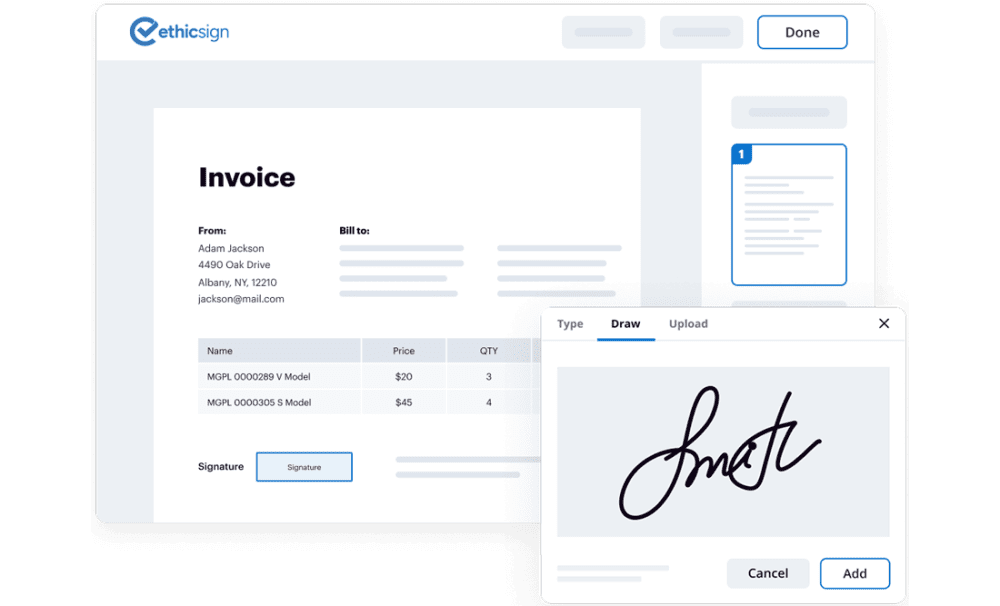Sign anywhere, anytime.
Discover the power of paperless with ethicsign
Upload your documents, sign them, and share them. Speed up your signature and approval processes while saving on shipping and stationery expenses.
No credit card required

Secure and Easy Electronic Signature Platform for Fast, Secure, and Paperless Signatures.
The acceleration of signature processes and the reduction of costs have become more important than ever in the business world. If you are seeking a solution to overcome the limitations of traditional signature methods, move your operations to the digital world, and optimize your workflow, here is an innovative solution for you: ethicsign.

Affordable Prices
Start using it for free now and if you are satisfied, you can make a purchase. By digitizing the document signing process, you save on paper, ink, and postage expenses. This way, you not only reduce costs but also demonstrate an environmentally friendly approach.

Fast signing processes
With the ethicsign platform, you can instantly sign and transmit your documents. Say goodbye to long waiting times and paperwork. Speed up your business processes and communicate faster with your customers or business partners. Use your time more efficiently.

Easy usability
With a user-friendly interface that anyone can easily use, electronic signing is now possible with just a few clicks. Our system is designed to be user-friendly, allowing you to complete your transactions quickly and seamlessly. By prioritizing user experience, we provide time and effort savings.

Priority on security
Protecting your data and signature is our priority. We keep all your communications and signature processes secure with advanced encryption technologies and security protocols. We take every step to ensure the highest level of security for you.
Utilize ethicsign’s legally compliant and user-friendly features.
ethicsign can serve to maintain secure paperless workflows while reducing operating costs and increasing productivity

Signature stamps
ethicsign presents the electronic signature of a user together with their printed name, signing date, and time.

Audit Trail
Authorized parties and ethicsign users can effortlessly access a comprehensive record of any modifications made to their documents.

Session inactivity timeouts
To ensure security, ethicsign automatically logs out users who remain inactive in the background for an extended period of time.

Signature IDs
Each eSignature on ethicsign is associated with a distinct ID code that links it to an electronic record, thereby preventing any attempt to delete or replace the signature after it has been applied.

Advanced encryption
ethicsign ensures the security of electronic records both in transit and at rest through the utilization of Secure Sockets Layer (SSL) and 256-bit AES encryption.

Two-factor authentication
ethicsign users can prevent unauthorized access to their documents by requesting signers to verify their identity through a password, phone number, or text message (SMS).

Notificaiton
Receive notifications at your convenience and never miss out on processes, thanks to ethicsign reminders.

Bulk Signing
With ethicsign’s bulk signing feature, sign all your accumulated documents with a single click and save time.
Progress Tracking
Track the progress of all processes you create and sign using ethicsign’s user-friendly interface.
Connect ethicsign with your apps
Drive your business forward with ethicsign integrations. Initiate eSignature workflows without leaving your cloud storage.



Frequently Asked Questions
What is an electronic signature?
E-signature used to authenticate the identity of the signer and to indicate their consent or approval electronically. Electronic signatures are often used in various online transactions, contracts, agreements, and other documents to streamline processes and eliminate the need for physical signatures.
Is it legal to sign documents with Ethicsign?
Yes, it is. Etikimza is a platform that allows you to legally sign your documents. In 2000, the U.S. federal government passed the Electronic Signatures in Global and National Commerce Act (ESIGN). Ethicsign supports this and similar laws. However, the scope of its use and types of documents you can eSign depend on the specific regulation inside your country.
Will my signers need to purchase an Ethicsign account?
No, it will be sufficient to purchase your ethicssign account. Signers you request to sign do not have to pay a fee.
Can I sign legally while using the trial version?
Yes, the documents we signed during the trial version are legally signed. But when your trial version expires, your unfinished processes may become blocked.
Is my card information safe?
E-signature used to authenticate the identity of the signer and to indicate their consent or approval electronically. Electronic signatures are often used in various online transactions, contracts, agreements, and other documents to streamline processes and eliminate the need for physical signatures.
Is a digital signature the same as an electronic signature?
A digital signature is a more secure type of electronic signature. It uses cryptography to bind a signature to a document and verify the identity of the signer. This makes it more difficult to forge or tamper with a digital signature.
In which workflows can I use Ethicsign?
You can use the Etikimza Platform in all processes that require a wet signature. Thanks to Etikimza smart process management, you can adjust the signature order in your workflows as you want.
Can Ethicsign access my information and documents?
It is not possible for any institution other than you to access your information and documents. You can read the privacy notice about this issue.
How do I contact Sales?
You can check our plans&pricing page to purchase. Contact us for questions about packages.
Do I need a credit card for the trial version?
No, you can experience ethicsign without entering credit card information.
